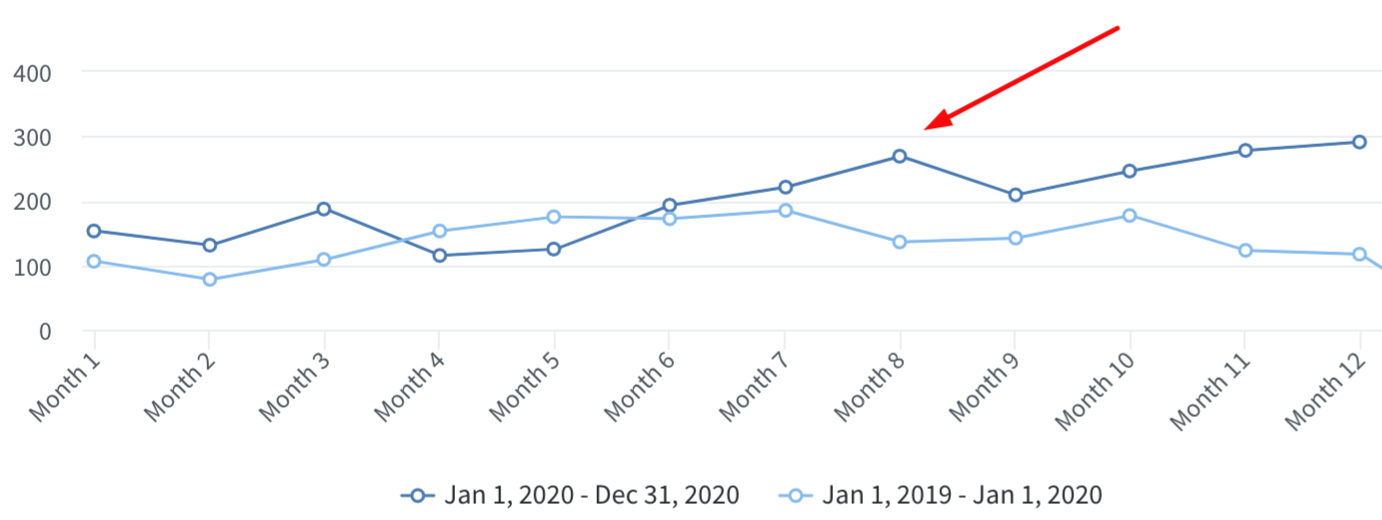This is a guest post by Ryan Amen, Director of Client Success at Nifty Marketing. As one of CallRail’s Agency Partners, Nifty Marketing has a passion for helping law firms achieve success online. Nifty offers law firms website development services, content strategy and marketing, SEO, PPC, video, and more.
As a legal practitioner, you need to make the most effective use of your time so you can run your business efficiently. While relying on gut feelings might be useful to better understand your prospective clients’ motives or help you foresee the opposing counsel’s next move, gut feelings are probably not as helpful as hard data when it comes to making better business and marketing decisions that will return positive ROI.
As a marketing agency that helps law firms generate revenue with call tracking, we often come across questions from our clients about the tool. If this is your first time hearing about call tracking and you want to learn more, here are some questions — and the answers — to some of the top call tracking questions we hear from our clients.
1. What does call tracking do to improve the ROI of your law firm?
Call tracking provides data, and that data helps you ask the right questions. The amount of information that can be gained and analyzed from call tracking is deep and wide. You can discover everything from caller ID information to site visitor referrers, meaning where the user came from before they landed on your site.
The main concept is that this data can help members of a law firm understand what is and isn't working so that you can ultimately formulate answers to the questions brought forth in the process of analyzing it. Generally, the more data you have, the easier it is to make better marketing decisions. For instance, what would you do if you could tell exactly which page a website user visited and then called your law firm? What could you do if you knew which pages were converting the most to legitimate phone call leads? This information is made available through call tracking. Now the question is how do you take advantage of it?
2. What information do you get out of call tracking on a law firm’s website?
You can get all the typical information from call tracking which you might get from caller ID (name, number calling, time, duration of call, etc.). Call tracking, however, can help you:
- Track how many how many calls your business missed and when they were missed
- Analyze time-of-day & day-of-week trends for missed calls
- Pinpoint the webpage a caller initially landed on when they came to the website
- Track how the user got to the site (e.g., from a search engine, Facebook & other social media, direct visits, Google Ads, other websites, etc.).
This information can be further synced up with Google Analytics to track phone calls as goals so you can see website & Google Ads performance (in relation to phone calls) right in your Google Analytics dashboard. Once you start pairing the analytics & call data with your internal intake lead & conversion tracking data, real magic can start happening. This is how you start to understand what your true conversion rates look like. You can then begin to determine what kind of ROI you are actually getting for your ad dollars. We’ve worked closely with law firms to copiously analyze their intake data they have and cross-reference it with CallRail and Google Analytics data so we can all, as a cohesive team, make the best marketing decisions possible. We find that everyone is more effective when a law firm and their marketing partners can be transparent with the data both sides have & use all of it for the betterment of everyone’s efforts who are involved. This keeps us all moving in the right direction and on the same page.
3. What can call tracking tell you about the effectiveness of your law firm's website and marketing efforts?
Monitoring call volume from different channels over a period of time and comparing to other timeframes (before & after changes have been made) can be very helpful in determining what may or may not be working. This includes whether or not the layout, design, and structure of your website is accomplishing all of your purposes. In a similar manner, it can help you understand what’s working with your digital marketing efforts and Google ads campaigns. It’s fairly easy to compare how many calls have been made from users on the site at different time durations.
If your website has been redesigned, rewritten, restructured, etc., you should absolutely track calls several months (years would be better) in advance so you can see the before and after effects of those changes. You can even break down the data in a page-by-page analysis to see which pages lead to calls after a user lands on them. This can be a very telling metric to a page’s effectiveness. If you’re developing new content and adding new pages regularly as part of your law firm’s marketing strategy, call tracking can help you pay attention to whether search engines are ranking these pages and if they’re leading to conversions.
4. How can it improve the effectiveness of a law firm's marketing campaign?
Much of it depends on how much effort you and your law firm marketing partners want to put into understanding it. With only the core information, it’s fairly easy to tell if some things are working. For instance, you can readily see if calls are being generated from a Google Search Ads campaign via ad extensions and landing pages. You can also easily see if a specific page developed on your website is leading to any calls after users land on that page. However, there are other insights that aren't as obvious.
For instance, if a landing page is performing exceptionally well, it isn't always apparent why this is the case. You may want to analyze the copy, the layout of the page, and/or even the design to better understand what sets that page’s performance apart. Once you feel you've determined what the key factors of the page's successes are, you can apply similar elements elsewhere to test your hypothesis. If it proves true, then continue applying it elsewhere. If one Pay-Per-Click campaign is generating calls that don’t convert to cases, maybe its targeting is set up poorly. Maybe the headlines are attracting tire kickers or discount service seekers who end up disappointed because they were misled by ad copy when they called. The data’s job is to bring up questions that typically take further analysis & testing so you can find answers. Data alone simply leads to discoveries; when data is combined with action, these can be powerful tools for improvement.
Often the best starting point is simply recognizing the channel which is bringing in the most qualified leads right now. Knowing this information can be enough to act on to improve results. In one recent example with a client of ours, being able to qualify leads from different channels was enough for us to know where to start. We wouldn’t have been able to gain these insights without being able to record and listen to calls through CallRail.
We determined that this client's calls from their Google My Business page happened to have the highest percentage of qualified leads. We made some changes to the client’s campaign and acted immediately on something we knew _could _help his local presence but had been (up to that point) lower priority and scheduled out for a while in favor of other efforts. These efforts helped improve the client's local rankings. Since doing this, we’ve seen a noticeable uptick in overall and qualified calls from Google My Business.
Since this channel currently had the highest percent of qualified leads, the client is closing cases and thus grateful for our ability to be agile and shift focus. This was only made possible through the insights available through call tracking which ultimately has resulted in a 50% increase in calls from Google My Business comparing 30 days prior to 30 days since we first implemented the changes.
5. How does call tracking work on your website?
The best way to set up phone call tracking is with a pool of numbers that dynamically swap the phone numbers on your website. The number pool allows a single number to get randomly assigned to a single user (one number per active user at any given time). This is done via a script of code on the site. All that is needed to utilize this number pool is the script which is added to the header across pages on your website where you want to track phone calls. This can usually be done via global settings which your marketing partners can easily implement for you. What happens after the script is added is this: a user comes to the site, the page loads and the script kicks in searching for a specific phone number (whatever number is hardcoded on the page, usually in the header), the script finds and changes the number to one from your pool of numbers, and this number sticks with the user throughout the rest of their visit. The number change usually happens very quickly, before a user can see or notice the original phone number appear and before the page is completely loaded.
6. Can law firm call tracking software integrate with other systems your firm already utilizes?
Good call tracking software should integrate with several types of other commonly used software. CallRail can integrate with Google Analytics, Google Data Studios, DataBox, Agency Analytics, many CRMs, and various other software which many law firms use.
7. How does call tracking result in more client leads from your law firm's website?
With solid analytics, data, and effort to answer the questions the data brings forth, you can double down on the efforts that are working well and end up getting more bang for your buck in the form of lead generation from your website. It requires constant effort to look at the data, consider the questions it brings up, and put forth the effort to solve those puzzles. Then it’s rinse and repeat. That seldomly means scrapping everything and starting from scratch. It’s usually a matter of continually making sure efforts are producing leads and continuing or expanding those efforts where possible. If an effort stops producing, you have the ability to analyze the data again to find out why. Does it need to be adjusted or do you need to completely shift that energy into something that is producing more fruitful results?
For example, we had a client spending a lot of marketing dollars on leads from a specific referral partner of theirs. While working closely with the client to analyze all their case sources going back several months, we traced their clients back to their source of origin using CallRail data. We were able to determine that this particular marketing channel was not only producing very few calls, it was producing even fewer leads that actually turned into cases.
We showed these findings to the client who then decided to reallocate that budget into other campaigns which were producing more calls, which led to more cases. This reallocation immediately resulted in more call volume (45% increase in the first month). The increased call volume averaged about 73% on a monthly basis for the remaining 5 months of 2020 in comparison to those same months the previous year.
8. How can call tracking improve a client's experience with a law firm?
There is one feature that is a no-brainer solution to answer this question, and that is Call Recording. If your intake team is losing potential clients because of how they're answering the phone, knowing that it’s happening is the first step toward fixing it. At best, it could be a matter of better training. At worst it might be a matter of hiring better people. Another way call tracking can improve client experiences is through analysis of the missed calls report. Is your intake team not answering calls for an hour after lunch or the last hour of Friday? Are the calls that were supposed to forward to your after-hours answering service not getting answered? That can be easily discovered from this report. We’ve seen firm leaders who assumed their intake team was answering every call only to be only to be shocked to find from CallRail’s missed call report that 5-10% of their calls were going unanswered (either to voicemail or worse, ringing indefinitely)! Things like this are usually an easy fix if the right person at the firm is aware it is happening.
One more no-brainer is call-flows. If you have specific intake people to handle specific issues or people to whom you need to forward certain types of calls, a calling tree might be the best answer to allow users to make a selection. You can even automatically send a call based on caller location to a specific person or office. Callers getting to the appropriate person faster is obviously a better user experience than being transferred multiple times or even once more than necessary. Call flows are also a great way to ensure no calls go unanswered, using features like Round Robin (dials numbers in sequence after a specified waiting period), or Simulcall (dial multiple numbers at once).
9. What call tracking features should a law firm be using from its call tracking software?
Here are some phone call tracking features that you should be using in your law firm and why:
- Visitor-level Tracking: This allows you to collect much more data than setting up a single static number will. The reason for this is that each active user has a phone number unique to them while they are on the site so when/if they call, it can be determined what page they are on, where they came from before visiting the site, what page they initially landed on when they came to the site, etc.
- Call Recording: So many potential issues can be uncovered with your intake process by listening to a few calls here & there. Call recording allows you to do that. Nobody wants to invest in marketing efforts just to find that those prospective clients are then getting lost through improper intake methods, especially when those efforts really start producing high volume lead generation which would otherwise convert to clients. In our experience, we've utilized call recordings to uncover things like: issues with business phone systems, low and high-quality trends of calls from specific channels, needed adjustments to intake team etiquette, a need to address drop-offs (like large drop-offs during lengthy intro recordings), etc. Call recording has the potential to fix issues like this early on before you lose further potential clients & cases if left unchecked.
- Google My Business Integration: This allows you to insert a tracking number onto your Google My Business page to get better insights into calls taking place there. (Note: GMB dramatically underreports calls here so this will paint a much clearer picture to actual call volume.) It also gives you an alert if your business has been marked as closed on GMB.
- Missed Call Notifications: This is exactly what it sounds like: a simple email notification to let the owner or an admin know there was a call missed. Missed calls at certain times of the day can be a real problem for some law firms & what’s worse is the owner usually has no idea it’s happening without something like this in place.
- Auto-responses: This goes hand-in-hand with Missed Call Notifications and allows you to send an automated text to missed callers letting them know someone from your team will attempt to get in touch with them. This could stop a potential client from moving on and contacting a competitor.
- Whisper Messages: This allows for a short message to your intake team when a phone call comes in. It can let them know what the source of the call is for better law firm marketing analysis and lead attribution on the fly.
- Keypad Scoring: This is another lead analysis tool that can be used to score the quality of leads as they come in. It allows your intake people to take a quick keypad survey at the end of each call after the caller hangs up.
10. Are There Other Benefits of Using Call Tracking for Law Firms?
There are other advanced features like Automation Rules that can be utilized to search for terms that will help categorize calls (even through transcription) for better attribution. This can prove very useful when tracing back calls that actually convert to clients. One of the main benefits of all this data and effort is Peace of mind. Knowing that your advertising dollars, which you’ve invested into your digital marketing efforts, is generating a positive ROI is absolutely priceless.
When Will You Implement Phone Call Tracking Solutions Dial in Attribution?
There’s no reason to rely on gut instincts and/or clients to tell you how they find out about you and your business. We have amazing analytical tools, CRMs, and phone call tracking software to help you make more informed business decisions. When used together properly, these can give us much better insights than we’ll ever get from memory & gut instincts. It's possible to drastically improve your ROI when you implement call tracking and when you're willing to take action on insights it brings forth. What is the sense in waiting when you can be using this kind of data to your advantage right now?











